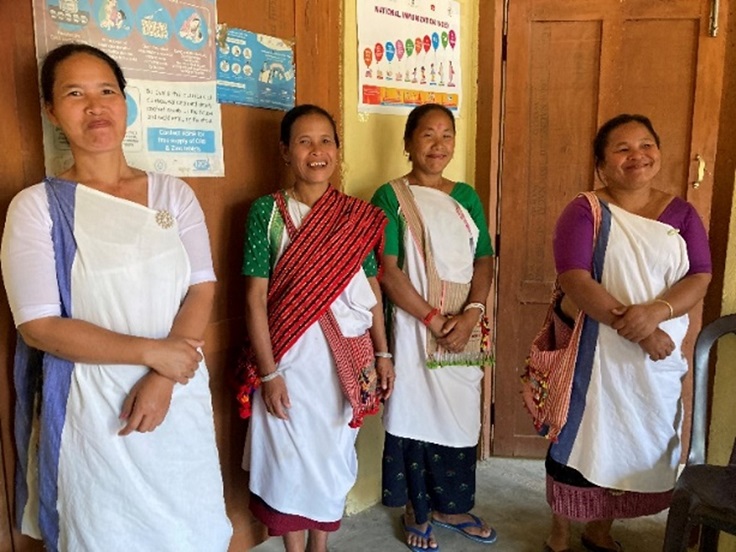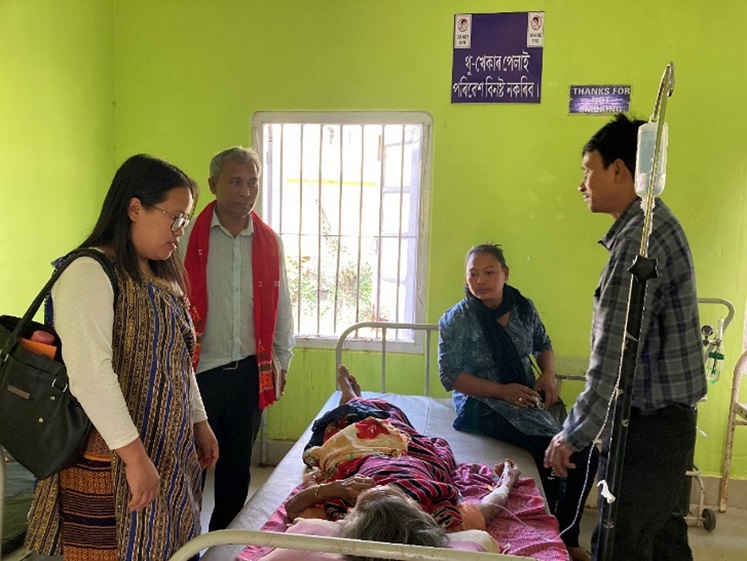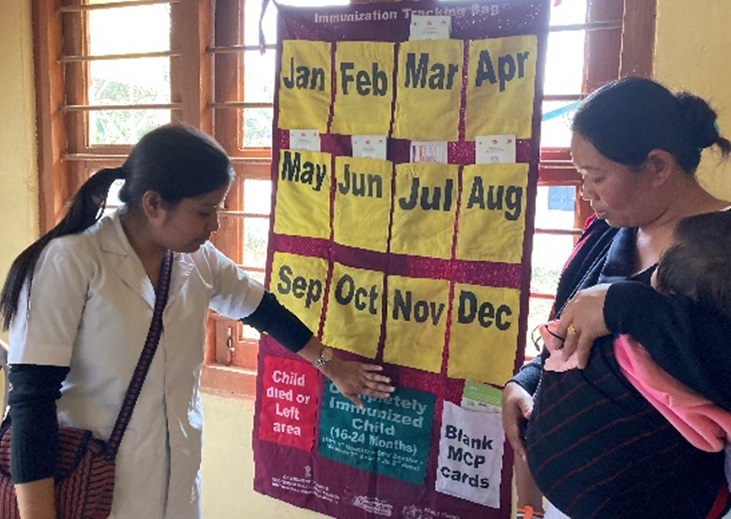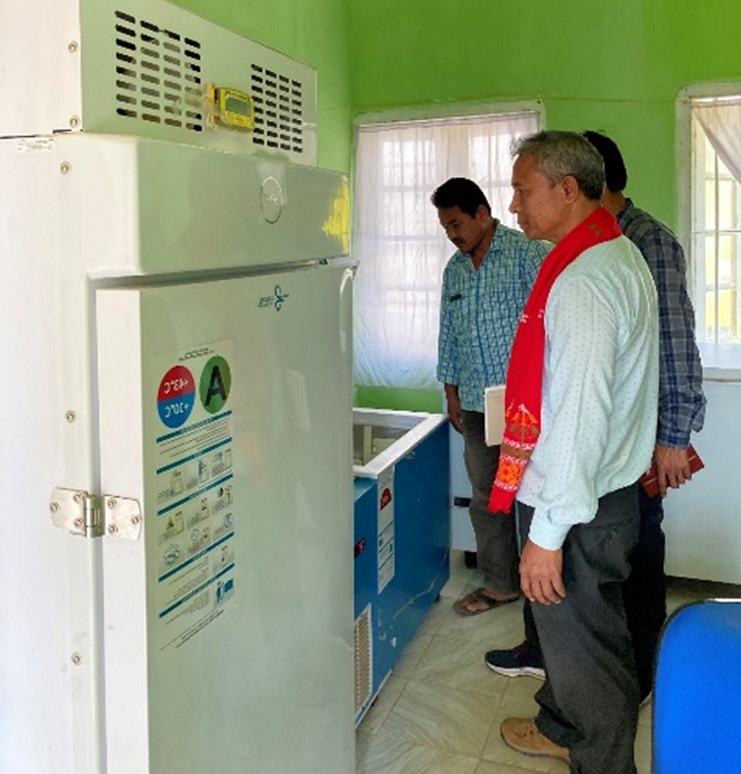The expansion of the road network and strengthening of health infrastructure, particularly in hard-to-reach areas of Assam, has empowered the public health workforce to deliver quality services to rural communities living in sparsely populated and remote hamlets in Donkamokam block in West Karbi Anglong district, Assam. This hill district is home to a predominantly tribal population, with Karbis, Bodos, Dimasas, Tiwas, Khasis, and Garos constituting the major ethnic groups.

ASHAs (community health volunteers in blue-bordered pekok draped across the body) at Derajuri Kilingrongsopi Sub-Centre under Donkamokam Block PHC in West Karbi Anglong work in tandem with anganwadi workers (in green) to urge mothers to seek primary health care services and get their children fully immunized. (Photo: Sanchita Sharma / © WHO India)
“Improved connectivity has made it easier for people to access primary and secondary health care, including universal immunization services, ante- and post-natal care, and childbirth services at the Block Primary Health Centre (BPHC) and Rural Hospital. It has also made it easier for ASHAs to visit far-flung villages to counsel families to seek immunization and primary health services,” said Dr Biren Ch. Tumung, Sub-Divisional Medical Health Officer, Donkamokam, West Karbi Anglong.
Health infrastructure strengthening in the state is visible Rural Hospital in Donkamokam BPHC, which has a dedicated labour room, baby-warmer and a maternity ward with four beds. The hospital, which has a cheerful canary-yellow façade and clean and airy wards painted lime green, serves a population of around 183 000 living within a 10 km radius.

Dr Biren Ch. Tumung (right), Dr Clement Teron (red scarf) and Ms Sapna Engtipi visit patients in the general ward of Rural Hospital in Donkamokam BPHC. (Photo: Sanchita Sharma / © WHO India)
With improved services at point-of-care, the health workforce and community mobilizers are reviewing efforts to lower the number of home deliveries, which remain high in some villages around Donkamokam BPHC. Derajuri Kilingrongsopi Sub-Centre serves some such villages, where there were 68 institutional births and 27 home deliveries between April 2022 and February 2023. “We, along with ASHAs and ANMS, are working closely with the community to support more families to seek ante-and post-natal care, and go for institutional deliveries for safe and respectful institutional childbirth. We hold regular meetings with the leaders, families, local influencers, Buddy Mothers groups and saas-bahu sammellans (mothers-in-law and daughters-in-law meetings) to inform people about the health services available,” said Ms Sapna Engtipi, district community mobiliser, West Karbi Anglong.
The Derajuri Kilingrongsopi Sub-Centre organizes ante-natal and post-natal care clinics twice a week and an immunization day once a week. The sub-centre also actively rolled out three rounds of Special Immunization Drive (SID) 2.0 from December 2022 to February 2023 to vaccinate all ‘drop out’ and ‘left out’ children and pregnant women under Universal Immunization Programme (UIP).

ANMs Ms Rashmi Majumdar and Ms Melinda Hansipi use an ‘Immunization Tracking Bag’ or ‘tickler’ bag to track the immunization status of children from the community served by Derajuri Kilingrongsopi Sub-Centre. (Photo: Sanchita Sharma / © WHO India)
“The SID 2.0 drive covered areas beyond the general service area of the health sub-centres, including non-cadastral villages where there are no maps, temporary settlements in forest areas, tea estates, border areas and hard-to-reach hilly and normally inaccessible areas take full immunization over 90%.” said Dr Biren Ch. Tumung.
“ASHAs (community health volunteers) went house-to-house to identify children who have missed doses, while ANMs speak to mothers who bring their young children to the anganwadi centre (rural childcare centre). They are from the community, mothers know them, they trust them. Now more people are seeking primary health care services at the sub-centre,” said Ms Melinda Hansipi, auxiliary nurse midwife (ANM), who often brings her baby to the sub-centre on immunization days to convince other mothers to get their children fully immunized like her own.
“We maintain a ‘due list’ for all children and routinely follow up with families to remind them about upcoming immunization appointments. We have been getting the vaccines and medicines needed in time, there have been no delays or shortages,” said ANM Ms Rashmi Majumdar.

Dr Clement Teron and colleagues taking stock in the vaccine storage unit at Rural Hospital in Donkamokam Block PHC. (Photo: Sanchita Sharma / © WHO India)
The sub-centre is under the Donkamokam Block PHC, which has cold-chain refrigeration equipment – including refrigerators, deep freezers, cold boxes, vaccine carriers, and icepacks – for storing vaccines at the recommended temperatures to maintain viability during distribution and delivery to the last mile.
“We use Electronic Vaccine Intelligence Network (eVIN) that provides live digital updates on vaccine stocks and temperatures. We also conduct monthly stock and wastage reviews to ensure no vaccine shortages at the immunization session sites. Regular reviews of temperature monitoring records are also done to ensure vaccine safety and potency,” said Dr Clement Teron, District Immunization Officer, West Karbi Anglong.
WHO National Public Health Support Network provides technical and field support to the Government of India and state governments for acute flaccid paralysis surveillance for polio, fever and rash surveillance for measles, and achieving full routine immunization, including special immunization drives.